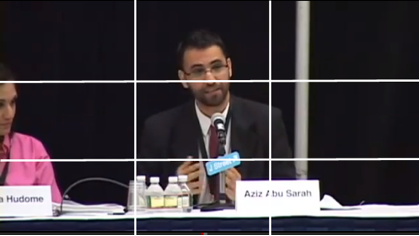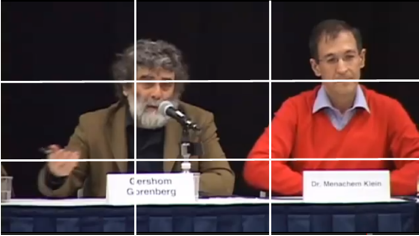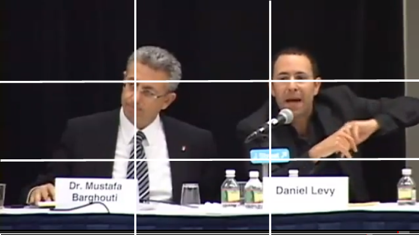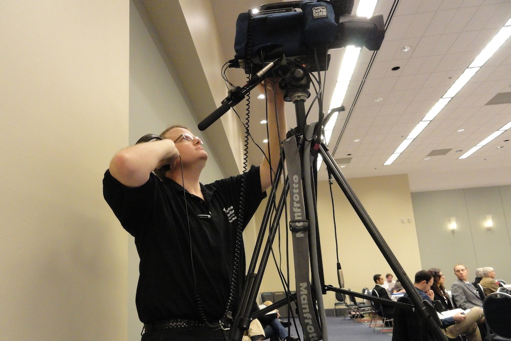Live from J Street, Part 2: Framing Tips for Conference Shooters and Webcasters
Jan Ozer passes on several key tips on framing panels and applying the rule of thirds (and when to break it) gleaned from his recent gig webcasting the national J Street conference on Israeli-Palestinian relations.
Tough Shots at the Table
Once the speakers finished at the podium and the discussion started at the table, the rules changed and became much more fluid. If the speakers were far enough apart, Zottig would frame them normally. You can see this in Figure 5 (below), where the speaker to the subject's right was visible, but not distractingly so.

Figure 5. Normal rule-of-thirds positioning when the speakers are sitting far apart
What happened when the speakers sat closer together? Zottig would violate classic positioning to avoid noticeably cutting off the adjacent subject. You can see this in Figure 6 (below), where author Gershom Gorenberg is speaking. Rather than place him in the center of the frame, which would very noticeably cut off Dr. Klein to his left, he framed them both, almost like both of them were speaking.

Figure 6. Avoid rule of thirds when it would noticeably cut off adjacent speakers.
At the other side of the podium, Zottig had the same problem plus another. That is, if he placed Daniel Levy in the middle of the frame, he would cut Dr Barghouti in half and expose the edge of the curtain on the right. To avoid both issues, he framed the shot to show both, even though Levy was doing the talking (Figure 7, below).

Figure 7. And avoid rule of thirds when it would noticeably show the edge of the stage.
I've long followed this "don't cut-off" in my concert productions, for example, where zooming into the banjo player would cut the adjacent guitar player in half. Basically, your job is to create the most attractive picture in the frame.
Let's add 2 more to our rules above:
- Follow speakers to and from the podium.
- Ignore the rule of thirds when it would noticeably cut off an adjacent subject or expose some other unattractive component of the setup. Remember: Only pros know what the rule of thirds is. All viewers know that it's awkward when you cut adjacent speakers in half.
You're certainly free to disagree with how Zottig (Figure 8, below) framed his shots. What's most important is to understand the issues that are at stake, make decisions about how to address them, and then apply those decisions uniformly.

Figure 8. The master at work
I didn't participate in the exercise to write about it; it was a purely commercial venture. However, it was fun and instructive watching the precision and care that Zottig used while framing his shots; over two days, the framing never looked awkward. Looking at his résumé, which includes training at the Art Institute of Philadelphia and years of TV and event production, it's no surprise. And there are obviously a lot of valuable pointers that any of us can pick up when collaborating on shoots with others who have different backgrounds or levels or types of experience than we do as shooters, producers, and webcasters.
Related Articles
In this final segment of this series on the JStreet Making History convention webcast, we'll examine one aspect of webcast production that too often gets ignored: monitoring and controlling audio volume, which becomes a complex issue as speakers change, audio techs and shooters adjust their own levels, and the webcaster is left to make sure the signal sent over the web remains audible and consistent.
HP's Z1 is the first all-in-one computer with workstation components and field serviceability. Here, encoding expert Jan Ozer takes a look at how this workstation-class portable PC fared in a live production and webcast environment, with testing emphasis in 3 areas: rendering, streaming encoding, and live encoding.
During a 3-day gig as webcaster for J Street's Making History conference on Israeli-Palestinian relations, Jan Ozer learned a lot about the challenges of streaming events where you don't control critical factors like the set background and lighting. In part 1 of 3 on this project, Jan details the planning process and streaming setup.